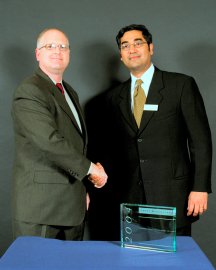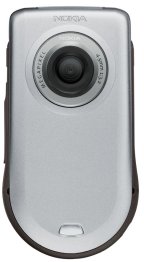Telemorphic Wins Frost and Sullivan Customer Value Enhancement Award
.

�  |
I received an invitation to attend the Frost and Sullivan Customer Value Enhancement Awards held in Boston last week. The invitation came from Telemorphic, the company best-known for its Web mapping technology, which lies behind David Rumsey's website. Telemorphic received the award in the geotechnologies industry in recognition of its product MultiViewer, an extension for ArcGIS. I'm confident Telemorphic, was the smallest company to receive an award among the 28 winners representing industries as varied as digital asset management, pharmaceuticals, and telecommunications.
The evening started out with an introduction from Frost and Sullivan's President Krishna Srinivasan. To my relief, he explained what customer value enhancement meant. The most valuable way to see it, I think, is in contrast to customer service. Customer service refers to making customers happy, being reactive, but also by preventing potential complaints. Customer value enhancement refers to helping customers reach the highest level of return on investment. It's typically proactive. Srinivasan went on to highlight that analysts within Frost and Sullivan use objective criteria to compare companies within each area to determine the winners. He noted that the award will help companies distinguish themselves from others in their space, enhance employee morale, and increase stock prices. The last one was said a bit tongue-in-cheek (and generated jokes by winners in their speeches, throughout the evening), but it's clear investors do notice these types of awards.
Jeff Otten, the president of Stentor, a medical imaging firm also receiving an award, gave the keynote. It turns out he was the president of Brigham and Women's Hospital (B&W;) here in Boston for some time before heading out to find a way to make technology "really work" in the medical arena. In one of his first meetings with the medical staff at B&W; he discussed customer service and a doctor was annoyed. The doctor felt it was not correct to refer to patients as "customers." When Otten explained that patients are required to wear johnnies, wait long hours while others are treated, and receive information only deemed acceptable by the doctor, he suggested that patients clearly were not treated like customers. And, that was a problem.
He went on to note that he sought a technology that would be a platform for medical care, much like ATMs are a technology platform for banking. He ended up at Stentor, a company which was trying to bring medical imagery into digital form. While it sounded like an easy and logical step, there was a problem, one we in geospatial technologies can appreciate. When scanned, the medical images lost some of the important subtlety that doctors needed for interpretations. With that problem solved, Stentor developed an enterprise system to distribute the images across a hospital. That meant patients never needed to carry films and that medical personnel personal had access to the files when needed. Stentor now leads its space in customer service among competitors including General Electric, Siemens and Philips. (I think it's interesting to note these companies they also have plays in geotechnologies!) The lessons Otten used to summarize his talk include the fact that disruptive technologies can even impact conservative industries, like medical care, and that keeping a goal of maximizing value to the enterprise will serve a company well. I share this story because I think it bears a striking resemblance to the challenges we have in geospatial businesses: professionals working with customers, enterprise distribution and data integrity.
As I listened to introductions of award winners and their brief acceptance speeches, I was amazed that the descriptions of the companies made what they did sound incomprehensible. When Bose Corporation received an award I was pleased that I knew what they did (they are the "speaker people," well known in in this area since the company is Boston-based). I had to work very hard to tease out even a vague idea of what the other companies did. That led me to question how many companies exist which provide products and services about which I know nothing. In fairness, many people don't know what we geospatial professionals do, either. During introductions to the pair from Telemorphic, CEO Todd Helt and CTO Andrew Waxman, my tablemates jumped directly to telematics applications when they heard "GIS and maps." Perhaps that was due to the fact that two people at the table worked in the aftermarket automotive arena.
As we flipped through the company summaries as awards were announced, we noticed Extensis. Waxman and Helt recognized the Celartem logo under the company name. Celartem, which owns LizardTech, purchased Extensis, a document asset management technology company, in 2002.
Telemorphic was recognized for "its ability to maximize the value of its offerings, and exhibit remarkable growth in a highly-competitive market, and for its successful launch of a new service protocol to improve overall customer ownership experience." Helt accepted the award noting that he had half of his staff on hand (himself and Waxman) and that the company was started four years ago in a basement with money from friends and family. I got the sense that the other winners thought what Telemorphic did was as foreign as I thought their companies' work was. Still, there was a definite sense from the winners, large and small, that the recognition of a job well done and confirmation that they were heading in the right direction with their customers, was most gratifying. And, as Helt noted to me later, being recognized outside of your industry was particularly satisfying.


More on Camera Phones
.

�  |
After last week's Point of Interest noting my skepticism on camera phones I received one baby picture via such a device. While that was pleasant, I also learned this week, that at least one local hospital provides a digital camera, website, and e-mail capability to new parents right at the hospital. Perhaps I reasoned, that's because they don't allow cell phone use?
An article at Tech News World this week took up the issue of cell phone cameras in the workplace. Recall that many gyms have banned such devices to ensure personal privacy is not threatened. In the workplace however, the article notes, disgruntled employees might capture and send information on the locations of security cameras, details of manufacturing layouts, or the specs on new products. Neil Strother, a senior industry analyst at In-Stat/MDR told the magazine he'd found the adoption rate of camera phones far higher than expected. Fifty million camera phones shipped worldwide last year, up from 18.2 million in 2002. So, clearly, I'm in the minority, as many others have found a compelling reason to own the device.
Stother notes that the initial response of companies to any type of threat by technology is typically to ban it. I noted a few weeks ago how several military bases screened Coke cans that might have a cell phone/GPS in them as part of promotion. Samsung Electronics, which ironically makes cell phones (including the model I have), has banned camera phones in its workplace. Pharmaceutical and financial companies are making similar moves. What hasn't been brought out in this discussion is that these types of workplaces often have traditional camera (and sometimes recording device) bans in place. I recall visiting workplaces where I was asked to leave cameras at the front desk and pick them up on the way out. So, at one level, the camera phone is but "another camera."
The issue of camera phones is more complex since camera phones are smaller and more people carry them everyday to work and everywhere else, in contrast to traditional large or small cameras. Not surprisingly, a few potential new technology fixes have appeared. Here's an easy one: if it's a company phone, "turn off" the imaging completely before assigning it to the employee. In fact, some companies are requesting phones from vendors that are delivered that way. (Why not just select a phone model without a camera?)
A more elaborate solution, from Iceberg Systems, puts a hardware/software combo into the camera phones and adds a transmitter that sends a signal to "turn off the imaging system" on the way into a building. On the way out, it's turned on again. I have to believe clever folks could override this, should they want to do so. (This reminds me of the new shopping cart system that locks the wheels when the cart crosses some "magic line." I can't say I've seen anyone try to disable that, at least not in broad daylight.)
Moreover, companies have to decide to put Iceberg's technology into the phones, increasing costs. So far, vendors haven't seen the demand. South Korea's government, however, is currently considering a law that would require all phones sold in that country to include such technology.
This whole discussion is essentially a location-based question. Some electronic activities, taking digital pictures in this case, are not allowed in some geographies, but are in others. There's ongoing discussion about technologies to "jam" cell phones in specific geographies, such as within a concert hall. Preventing inappropriate picture taking is the imagery equivalent.



Lake Powell: Name Confusion?
.

�  |
The Coalition to Rename Lake Powell is trying to do what its name suggests. The group hopes to change the name to Glen Canyon Reservoir and argues that the current name is misleading on two counts. First, the group argues the lake is not a lake but a reservoir, since it did not exist until the Glen Canyon Dam created it in 1963. Some argue that many people don't know it's not a natural lake and a name change would help clear that up. The second part of the argument is that there is another Lake Powell 280 miles away in Colorado and that might cause confusion.
Member of the Arizona Board on Geographic and Historic Names, and geography professor Robert Altschul, says the two arguments "don't hold any water, so to speak." The Board took no action on the proposal at a recent meeting and is looking for input from the Navajo Nation, a neighbor of the lake, on this matter and one other.
Others suggest the action is really aimed at lowering the level of water or perhaps ultimately, taking down the dam. They point to a political aim. Still with no members of the Board supporting the change, and the ultimate decision lying with the U.S. Board of Geographic Names, a change does not appear imminent.
Lake Powell is named after John Wesley Powell, who incidentally, named Glen Canyon in the first place.

Letters
.
� Reader Esther's son shared a link that provides more information on the reaction of Reason readers to the publication's recent customized covers. There are a number of links to print coverage about the covers and a discussion on National Public Radio's Talk of the Nation.
� John J. Troiano, Senior Account Executive at PlanGraphics, Inc. provided an answer to last week's query for a tool to use cell phones with GPS and cameras to capture and share imagery.
"Please direct Eric to Red Hen Systems. They have been providing this tool since at least 1998."
The editor notes: I contacted Red Hen Systems and learned its solution was announced in a press release last year. The company also shared some insight into its vision for camera phones.
� Reader Peter wrote to correct a geography error I made last week.
"Just a correction on the location of Symmetry Systems Inc., Bentley Systems acquired Symmetry Systems Inc. which is located in Clifton Park, New York not New Jersey."
� Aaron Roller sent an update on MotionBased, a website for tracking running, biking, and other routes, which received a "kudo" back in March.
"We would like to let you know that MotionBased is live and open for public beta registration. We invite you to check it out."

Points of Interest
.
Can't Get Enough? Read the latest Points of Interest daily on our website.
MapXtreme Pricing in Japan. Alps Mapping, the sole distributor of MapInfo products in Japan, will begin selling MapInfo MapXtreme 2004 later this month. A software development kit (SDK) license is available for 400,000 yen ($3,670), while the CPU license costs 2,000,000 yen ($18,349).